You thought it was just the writers? Not true! Artists get “blocked” too. If you, like many others, find a blank canvas rather daunting to stare at while trying to think up your next subject, here are a couple of techniques to help get your creative juices flowing.
- Research: Start looking for images that you like, or ones that consist of certain elements that you would like to incorporate into your own work. Look up artists that you like and analyze what it is that you find appealing in their works.
- Take Pictures: This is another means research, one that comes directly from you. Taking pictures helps us generate ideas and allows us to experiment without too much effort.
- Sketches: Sketches are also a means of research. Sketch what is in front of you; doodle any ideas that are floating around in your head. The important thing is not to think about it too much; just do it. You will have plenty to think about once you get it out and on paper.
- Self Portrait: When all else fails, draw yourself. It worked for Rembrandt.
- Shut your eyes: This is always a fun one. It is a very intuitive approach to composition, albeit chaotic. Again, don’t think about it; just move your brush around on the canvas. When you open your eyes, you will see something very abstract. It is just a starting point. The longer you look, the more you will start to see shapes and textures with tremendous potential.
————————————————————————————————————————————————————————————-
Systematic Approaches
- Axial compositions: Draw a vertical line somewhere across your canvas or working surface. Whatever you decide to paint or draw should fall either to the right or the left of the line you have drawn.
- Bilateral compositions: This is when all the elements of your piece flow out from a single line (usually a vertical one).
- Grids: Draw a grid on your canvas, dividing the space into nine squares. This gives you four points. Arrange your imagery so that your primary focal points fall on at least one of those points.
- Radial compositions: Draw a single point on your working surface. Everything you incorporate into your work should “radiate” or extend from that point.
- Modular compositions: Draw solid geometric shapes on your surface (squares work best). You can draw one; you can draw 20. Whatever else you decide to add is confined to the interior of those shapes.

